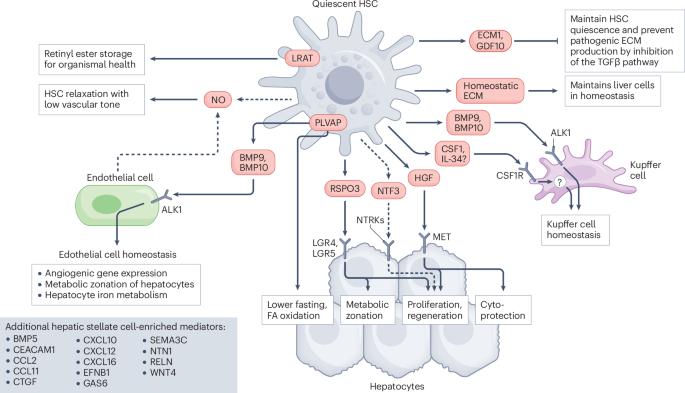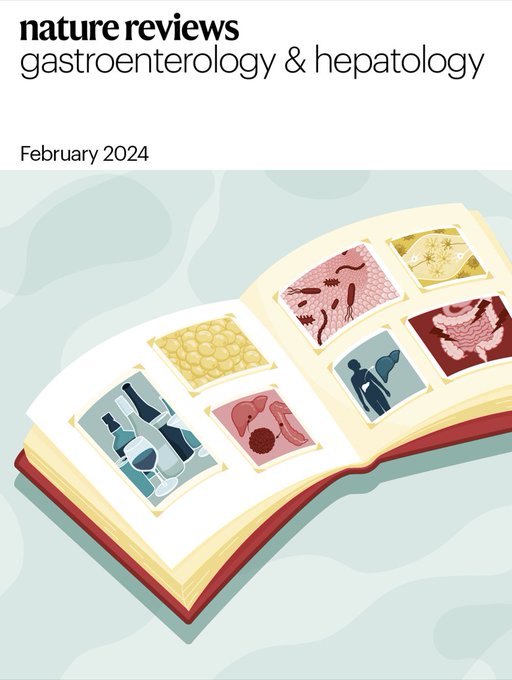Hepatic stellate cells: balancing homeostasis, hepatoprotection and fibrogenesis in health and disease
IF 51
1区 医学
Q1 GASTROENTEROLOGY & HEPATOLOGY
引用次数: 0
Abstract
In the past decades, the pathogenic role of hepatic stellate cells (HSCs) in the development of liver fibrosis and its complications has been deeply characterized, rendering HSCs a primary target for antifibrotic therapies. By contrast, the beneficial roles of HSCs in liver homeostasis and liver disease are only beginning to emerge, revealing critical regulatory and fibrosis-independent functions in hepatic zonation, metabolism, injury, regeneration and non-parenchymal cell identity. Here, we review how HSC mediators, such as R-spondin 3, hepatocyte growth factor and bone morphogenetic proteins, regulate critical and homeostatic liver functions in health and disease via cognate receptors in hepatocytes, Kupffer cells and endothelial cells. We highlight how the balance shifts from protective towards fibropathogenic HSC mediators during the progression of chronic liver disease (CLD) and the impact of this shifted balance on patient outcomes. Notably, the protective roles of HSCs are not accounted for in current therapeutic concepts for CLD. We discuss the concept that reverting the HSC balance from fibrogenesis towards hepatoprotection might represent a novel holistic treatment approach to inhibit fibrogenesis and restore epithelial health in CLD simultaneously. Hepatic stellate cells (HSCs) are best known as the primary fibrogenic liver cell type. This Review provides a comprehensive overview of protective and pathogenic HSC functions in health and disease and discusses novel therapeutic concepts derived from this dual role.


肝星状细胞:健康和疾病中的平衡稳态、肝保护和纤维形成
在过去的几十年里,肝星状细胞(hepatic stellate cells, hsc)在肝纤维化及其并发症发生中的致病作用已经被深入研究,使hsc成为抗纤维化治疗的主要靶点。相比之下,造血干细胞在肝脏稳态和肝脏疾病中的有益作用才刚刚开始显现,揭示了肝分区、代谢、损伤、再生和非实质细胞身份等关键的调节和纤维化独立功能。在这里,我们回顾了HSC介质,如R-spondin 3,肝细胞生长因子和骨形态发生蛋白,如何通过肝细胞,Kupffer细胞和内皮细胞中的同源受体调节健康和疾病中的关键和稳态肝功能。我们强调在慢性肝病(CLD)的进展过程中,平衡如何从保护性向纤维致病性HSC介质转移,以及这种平衡转移对患者预后的影响。值得注意的是,在目前的CLD治疗概念中没有考虑到造血干细胞的保护作用。我们讨论了将HSC平衡从纤维生成恢复到肝保护的概念,这可能是一种新的整体治疗方法,可以同时抑制CLD的纤维生成和恢复上皮健康。
本文章由计算机程序翻译,如有差异,请以英文原文为准。
求助全文
约1分钟内获得全文
求助全文
来源期刊
CiteScore
52.30
自引率
0.60%
发文量
147
审稿时长
6-12 weeks
期刊介绍:
Nature Reviews Gastroenterology & Hepatology aims to serve as the leading resource for Reviews and commentaries within the scientific and medical communities it caters to. The journal strives to maintain authority, accessibility, and clarity in its published articles, which are complemented by easily understandable figures, tables, and other display items. Dedicated to providing exceptional service to authors, referees, and readers, the editorial team works diligently to maximize the usefulness and impact of each publication.
The journal encompasses a wide range of content types, including Research Highlights, News & Views, Comments, Reviews, Perspectives, and Consensus Statements, all pertinent to gastroenterologists and hepatologists. With its broad scope, Nature Reviews Gastroenterology & Hepatology ensures that its articles reach a diverse audience, aiming for the widest possible dissemination of valuable information.
Nature Reviews Gastroenterology & Hepatology is part of the Nature Reviews portfolio of journals.

 求助内容:
求助内容: 应助结果提醒方式:
应助结果提醒方式:


